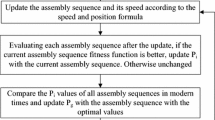Abstract
This paper proposes a furniture arrangement method based on a multi-agent approach for interior coordination. In the proposed model, each item of furniture acts as an agent, interacts with an environment and other agents, and moves to where it wants to go. Consequently, all items of furniture reach well-coordinated placement. The movements of agents in the proposed method are inspired by particle movements in particle swarm optimization algorithms, that is, the agent’s velocity is calculated from a linear summation of vectors to avoid constraint violations, to harmonize with other agents, and so on. A simple example shows that the proposed method can make a well-coordinated furniture arrangement from randomized positions.
Similar content being viewed by others
References
Durfee EH, Rosenschein JS (1994) Distributed problem solving and multiagent systems: comparisons and examples. Proceedings of the International Workshop DAI, pp 94–104
Wooldridge M, Jennings NR (1995) Intelligent agents: theory and practice. Knowledge Eng Rev 10(2):115–152
Stone P, Veloso MM (2000) Multiagent systems: a survey from a machine learning perspective. Auton Robots 8(3):345–383
Kitano H, Asada M, Kuniyoshi Y, et al (1995) Robocup: the robot world cup initiative. Proceedings of the IJCAI-95 Workshop on Entertainment and AI/ALife
Kennedy J, Eberhart R (1995) Particle swarm optimization. Proceedings of the IEEE International Conference on Neural Networks, vol 4, pp 1942–1948
Kennedy J, Eberhart RC, Shi Y (2001) Swarm intelligence. Morgan Kaufmann, Los Altos
Ono S, Izumi T, Fujiyama A (2004) Interior coordination using casebased reasoning and constraint satisfaction paradigm. Proceedings of the IEEE Conference on Cybernetics and Intelligent Systems, pp 1066–1071
Izumi T, Ono S, Nakayama S (2006) Case- and constraint-based interior design system. Syst Control Inf 19(7):293–295
Ono S, Hamada Y, Yamamoto S, et al (2001) Rearrangement of floor layouts based on constraint satisfaction. Proceedings of the IEEE International Conference on Systems, Man, and Cybernetics, pp 2759–2764
Author information
Authors and Affiliations
Corresponding author
Additional information
This work was presented in part and was awarded the Best Paper Award at the 15th International Symposium on Artificial Life and Robotics, Oita, Japan, February 4–6, 2010
About this article
Cite this article
Ono, S., Oshige, T. & Nakayama, S. A multi-agent-based approach for furniture arrangement. Artif Life Robotics 15, 161–164 (2010). https://doi.org/10.1007/s10015-010-0783-x
Received:
Accepted:
Published:
Issue Date:
DOI: https://doi.org/10.1007/s10015-010-0783-x




